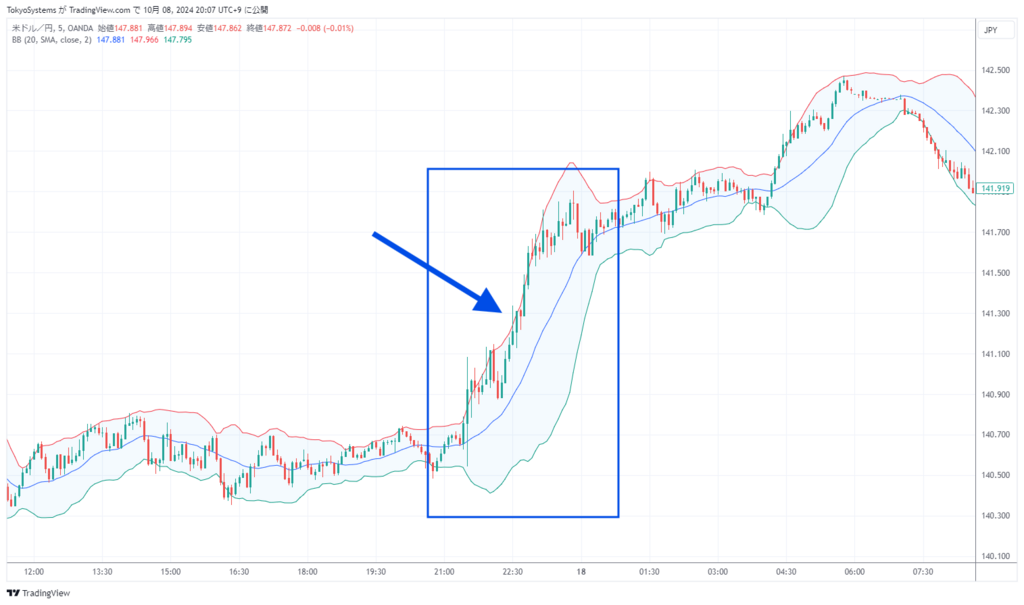In investing and trading, it’s crucial to utilize various methods and technical indicators. Among these, Bollinger Bands are widely used by many traders as a convenient indicator to visually grasp trends and volatility. Particularly, a phenomenon called “Band Walk” is considered a sign of a strong trend’s emergence and is a vital concept for pinpointing trade timings. This blog will comprehensively explain everything from the basics of Band Walk to how to identify it and its utilization methods.
1. What is a Bollinger Band Walk?
Bollinger Bands are a technical indicator used by many traders to visually represent market trends and volatility. Among them, a state specifically attracting attention is called a “Band Walk.” Here, we will thoroughly explain the concept of a Band Walk and its criteria for judgment.
Definition of a Band Walk
A Band Walk refers to a state where candlesticks align along the Bollinger Bands. This phenomenon, which occurs when a trend is sustained, is characterized by prices moving while touching the ±2σ (sigma) bands. Specifically, in an uptrend, candlesticks follow the +2σ band, and in a downtrend, they follow the -2σ band. Thus, a Band Walk is a visual signal indicating the presence of a strong trend, and many traders use it for trend-following decisions.
Expansion and Band Walk
A Band Walk is closely related to “expansion” of the Bollinger Bands. Expansion indicates that the band width is widening, signifying increased market volatility. When this state is confirmed, and a Band Walk subsequently occurs, it is recognized that a strong trend is continuing.
Visual Confirmation
A Band Walk has characteristics that make it easy to confirm visually on a chart. By focusing on the following points in particular, it becomes easier to determine the state of a Band Walk:
- Relationship with Moving Averages: When a Band Walk occurs, the price typically continues along the band without reverting to the moving average.
- Change in Band Width: When expansion is observed and the band width widens, it can also be interpreted as a sign of increasing trend strength.

Importance of a Band Walk
Identifying a Band Walk is extremely important for formulating a trading strategy. When this phenomenon is detected, it provides an advantage in determining entry into a new trend or timing for profit-taking. Especially for those new to trading, a Band Walk is a useful and easy-to-understand trading signal.
Points to Note
However, simply confirming the occurrence of a Band Walk and immediately jumping into a trend can be risky. Constantly monitoring market movements and combining it with other technical indicators is key to avoiding losses and maximizing profits.
2. Characteristics and Identification of a Band Walk
A Band Walk is a particularly important concept among trading methods using Bollinger Bands. This section will elaborate on the characteristics of a Band Walk and how to identify it.
Characteristics of a Band Walk
1. Clear Trend Formation
When a Band Walk occurs, the market exhibits a strong trend. This trend can usually be confirmed by candlesticks moving along the ±2σ of the Bollinger Bands. After expansion is confirmed, the market price typically does not return to the moving average but continues moving towards the outer side of the band.
2. Trend Strength and Persistence
During a Band Walk, there is a high probability that the trend will continue. Particularly, if there is a significant price movement compared to conventional price action, the trend tends to strengthen further.
How to Identify a Band Walk
To accurately identify a Band Walk, you need to grasp several key points.
1. Confirmation of Expansion
First, confirm that the bands are widening (expansion). The strength of the trend observed when the band width increases becomes a more reliable factor for the occurrence of a Band Walk.
2. Candlestick Movement
Observe the candlesticks clearly moving along the ±2σ bands. This serves as a sign of a Band Walk, and it’s particularly important to pay attention to whether multiple candlesticks maintain this state.
3. Timing Confirmation
It’s also crucial to identify the timing when a Band Walk occurs. Band Walks tend to happen more frequently during active market hours or around the release of important economic indicators.
Points to Watch Out For
There are several points to note when identifying a Band Walk.
Beware of False Signals
There are cases where a Band Walk appears to occur, but the trend reverses shortly after. Therefore, it is important to enter only after sufficient evidence has been confirmed.Combination with Other Indicators
When judging a Band Walk, combining it with other technical indicators (e.g., RSI or MACD) can enhance certainty. It is effective to comprehensively analyze market strength and trend reversal points.

3. Trade Entry Methods Using a Band Walk
Trading utilizing a Band Walk is a method to capture market trends and secure profits. Mastering entry methods and making accurate judgments leads to trading success. Here, we will thoroughly explain the steps for entry.
Step 1: Confirming Market Environment
Before making an entry, it is essential to understand the market environment. The points to particularly watch are as follows:
Bollinger Band Convergence (Squeeze)
A state where Bollinger Bands are converging indicates that a sharp price fluctuation is imminent. As convergence continues, the likelihood of a Band Walk starting increases.Trend Alignment
Check higher timeframes to confirm if the trends align. If the trends on lower and higher timeframes are in the same direction, the probability of a successful entry improves.
Step 2: Considering Entry Points
Once the market situation is understood, next find specific entry points. Refer to the following methods:
Support and Resistance Breakouts
When the price clearly breaks through support or resistance lines, it can be considered the beginning of a Band Walk, presenting a good entry opportunity. In this case, it’s crucial to confirm that the closing price definitively crosses the line.Breakthrough of ±2σ Bands
When the price breaks through the ±2σ bands, it is considered a strong trend signal. However, for entry timing, it is possible to seek a more favorable entry position by waiting for the price to return to the center of the band.
Step 3: Post-Entry Management
After entry, it is necessary to carefully observe price movements and manage them appropriately.
Profit-Taking Timing
Even if you feel the trend will continue, you should avoid being overly attached to pursuing profits. When the price rises, be mindful of exiting at a pre-set profit point. This strategy helps mitigate risk from sudden price fluctuations.Setting Stop-Loss Points
If the price unexpectedly falls, immediate stop-loss can minimize losses. Setting a stop-loss point at the time of entry allows for more confident trading.
Practical Trading Considerations
Trading using a Band Walk requires clear judgment and planning. Thorough entry timing and risk management can increase success rates. Regularly analyze the market and perform backtests to build your own suitable trading style.

4. Signs of a Band Walk Occurrence
Identifying the occurrence of a Band Walk is very important for traders. Below are some particularly noteworthy signs.
4.1 Line Break in a Ranging Market
In a ranging market, drawing horizontal lines at highs and lows can help ensure you don’t miss breakout timings. If candlesticks break these horizontal lines, it’s a strong sign that a Band Walk is likely to occur. Also, the longer the price consolidation before the breakout, the stronger the subsequent move tends to be.
4.2 Bollinger Band Contraction
Pay attention to the state where Bollinger Bands are contracting, also known as a “squeeze.” A squeeze indicates that energy for trend formation is building up. In such a state, a Band Walk is more likely to occur, so it’s especially important to pay close attention if the squeeze period is long.
4.3 Signs of Expansion
When the bands open, especially when the ±2σ or ±3σ open significantly, this expansion situation is also a sign of a Band Walk. When expansion occurs, the price often touches lines beyond ±2σ, which can also lead to a Band Walk. Waiting for the price to return to the moving average is one way to reduce trading risk.
4.4 Release of Important News
During the release of important information such as corporate earnings announcements or economic indicators, prices can fluctuate sharply. When prices move significantly due to such information, a Band Walk may occur, so it’s wise to always keep an eye on these events.
4.5 Higher Timeframe Indicating Trend Continuation
When looking for signs of a Band Walk, also check if a trend in the same direction is occurring on a higher timeframe (a chart with a longer time axis). Short-term trends are easily influenced by higher timeframes, so if the trend supported by the higher timeframe is confirmed, the probability of a Band Walk increases.
By being aware of these signs and observing market movements, identifying the occurrence of a Band Walk will be key to success in trading.
5. Band Walk Risk Aversion Strategies
When utilizing a Bollinger Band Walk, it’s essential to keep several risks in mind and implement strategies to mitigate them. Below, we’ll introduce specific methods useful for avoiding Band Walk risks.
1. Confirm Trend Strength
Before a Band Walk occurs, it’s crucial to confirm the trend strength. If the trend is strong, the Band Walk is likely to persist, but if it’s weak, false signals often occur, so caution is advised. To judge a strong trend, check past highs and lows or the relationship with moving averages.
2. Confirm Support and Resistance Lines
Being aware of support and resistance lines is also very effective for risk avoidance. If the price breaks these lines, it serves as a bullish or bearish signal, indicating the occurrence of a Band Walk. By confirming whether the line is clearly broken based on the closing price, you can avoid false signals.
3. Combination with Other Indicators
Using other technical indicators, such as oscillators or moving averages, can enhance the accuracy of Band Walk signals. This increases the decision-making factors for entry and exit, allowing for risk hedging.
4. Setting Stop-Loss
When holding a position, always set a stop-loss. This allows you to cope with unexpected price fluctuations and limit losses to a certain range. Especially in a Band Walk situation, it serves as a measure to minimize losses even if the price moves in the opposite direction.
5. Identifying Profit-Taking Timing
It’s also important to identify the appropriate profit-taking timing without being greedy for profits. Missing the end of a Band Walk significantly increases the risk of losing substantial profits. By exiting early when a certain profit is made, you can secure profits while reducing risk.

6. Adopt a Short-Term Perspective
Since Band Walks fluctuate rapidly, a short-term trading approach is effective. Holding positions for a shorter period than in swing trading makes it easier to reduce risk. Strive to quickly grasp market conditions and aim for small profits from minor movements.
By implementing these risk aversion strategies, you can further enhance the results of trading using a Band Walk.
Summary
The Bollinger Band Walk is attracting attention from many traders as a strong trend indicator. However, when utilizing a Band Walk, careful analysis and judgment are indispensable, including trend strength and coordination with other technical indicators. By thoroughly managing risk and identifying appropriate entry and exit timings, you can effectively utilize a Band Walk and achieve stable trading profits. To succeed in trading, strive to refine your trading style while being mindful of the various points explained here.
Frequently Asked Questions
What is a Band Walk?
A Band Walk refers to a state where candlesticks align along the Bollinger Bands. It’s a phenomenon that occurs when a trend is sustained, characterized by prices moving while touching the ±2σ (sigma) bands. Thus, a Band Walk serves as a visual signal indicating the presence of a strong trend.
How can I identify a Band Walk?
To accurately identify a Band Walk, first, confirming expansion, observing candlestick movements, and verifying timing are crucial. Additionally, combining it with other technical indicators can enhance certainty. Comprehensively analyzing market strength and trend reversal points is effective.
How do I enter a trade using a Band Walk?
When trading using a Band Walk, first confirm the market environment, then consider entry points, and finally manage the trade appropriately after entry. Identifying timings such as support/resistance breakouts and breakthroughs of the ±2σ bands, and clearly setting profit-taking and stop-loss points are key to success.
How can I avoid the risks of a Band Walk?
To avoid the risks of a Band Walk, it’s effective to confirm trend strength, be aware of support/resistance lines, and combine with other indicators. Setting stop-losses, appropriate profit-taking, and adopting a short-term perspective are also important points. By implementing these risk aversion strategies, you can enhance the results of trading utilizing a Band Walk.










